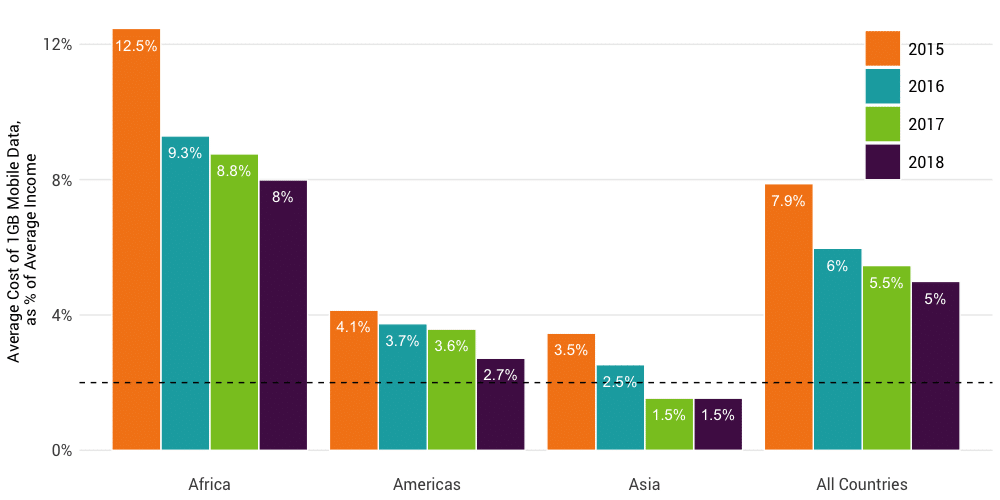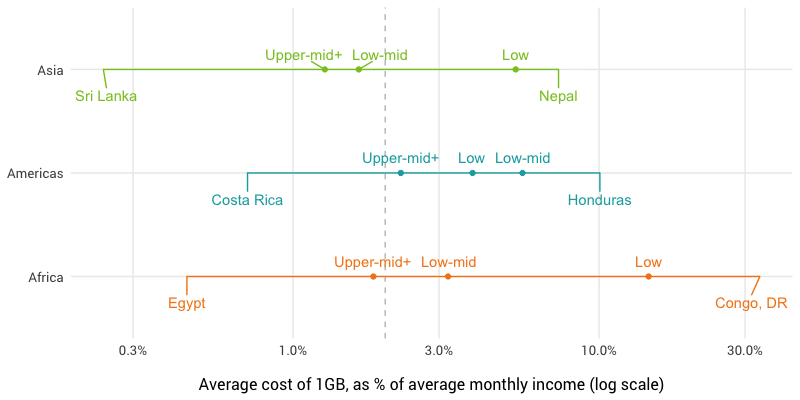This post was first published on a4ai.org and is based on Alliance for Affordable Internet (A4AI) research on data pricing in low- and middle-income countries
CORRECTION: An earlier version of this article, published 20 March 2019, wrongly reported that there was an increase in average data costs across low- and middle-income countries. This was the result of a methodological error inflating prices in a handful of countries. The error was identified after publication. We have corrected the mistake, and we’re sorry it happened. The updated data is available.
—
Over the past year, mobile broadband data costs dropped on average by 17% across low- and middle-income countries, according to the latest analysis from the Alliance for Affordable Internet. While prices are falling, the cost to connect remains unaffordable for billions. The latest data also suggests that a gap between countries is emerging, with average costs falling at a slower rate in low-income countries than in middle-income countries.
The divergent pace of change for those least able to pay for mobile data will exacerbate the existing digital divide and act as a barrier to greater social and economic equality. Without action from policymakers, the potential social and economic benefits from greater internet access and affordability will be further delayed.
For the past four years, A4AI has monitored mobile broadband prices across low- and middle-income countries to measure affordability and encourage policy change to lower broadband industry costs. Our latest data is based on December 2018 market prices and covers 99 countries, up from 59 countries in previous surveys. The data includes new price points for packages at 100MB, 500MB, 2GB, 5GB, 10GB in addition to 1GB.
Internet access remains unaffordable for billions
The latest pricing information reveals that across the 99 countries covered, 1GB costs 5.76% of monthly income on average, well above the ‘1 for 2’ affordability threshold, where 1GB of mobile data is priced at no more than 2% of the average income. In fact, only 31 of the countries we surveyed have affordable mobile broadband. This means that among those covered in this survey, almost 1.3 billion people live in a country where an entry level plan of 1GB of mobile data is not affordable. Billions more live in countries that meet the ‘1 for 2’ threshold but, because they have a lower than average income, they nonetheless struggle to pay for basic mobile data packages.

Fig. 1: Regional comparison of mobile broadband affordability (1GB) 2015-2018 (Note: includes the 60 countries covered in the A4AI Affordability Reports. For comparability, we limited the 2018 “All countries” bar to the same 60 countries.)
Affordability varies greatly within and across regions
The purchase of 1GB of mobile broadband data can mean wildly different things to a person’s budget depending on where they live. In Sri Lanka, for example, the cost of 1GB of data represents less than one quarter of 1% of the average monthly income, whereas in the Democratic Republic of the Congo, the same data package costs over a third of the average monthly income. For the majority of people in sub-Saharan Africa, the price of 1GB of mobile data is well beyond what is considered affordable and in fifteen countries across Africa, 1GB costs more than 10% of the monthly average income.

Fig. 2: Range of Mobile Broadband Affordability by country and income group within regions.
Progress is slower in low-income countries
This year, data costs fell more slowly in low-income countries than in middle-income countries. Looking at the 59 countries with data for both 2017 and 2018, the average cost of 1GB mobile data across low-income countries dropped from 12.9% to 12.3%, a decrease of 12%, remaining unrealistically high for millions of potential users. In comparison, users in middle-income countries saw average affordability move from 2.8% to 2.0%, a decrease of 19%.
Without critical policy action, this divergent trend for affordability means that low-income countries miss out on valuable opportunities for revenue and development. As the rest of the world continues to develop with the fast pace of technology, users in low-income countries that remain unconnected will face the growing costs of digital deprivation. Countries that fail to address affordability today will see unaffordable mobile broadband costs create deeper social and economic divides tomorrow.
The updated data is available to download as a CSV file.
For updates about our work, sign up to our newsletter and follow us on Twitter at @webfoundation.
To receive a weekly news brief on the most important stories in tech, subscribe to The Web This Week.
